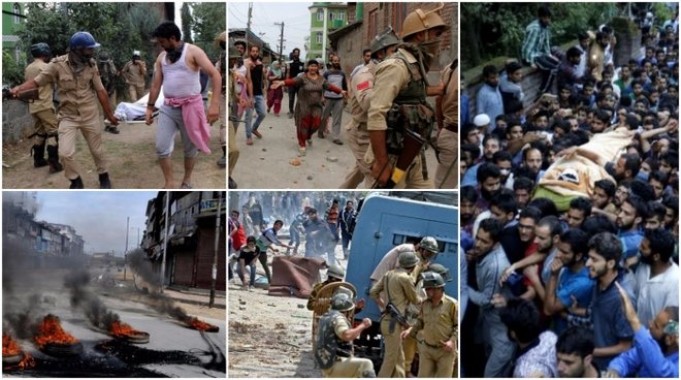Life and death in Kashmir, on social media
Violence in the state following Burhan Wani's killing

PoliTweet
Jyoti Malhotra
As many as 15 people have been killed by security forces in the Kashmir valley, while protesting in grief and rage the death of Hizbul Mujahideen militant Burhan Wani on the night of July 8. Meanwhile the BJP point person for Jammu & Kashmir, Ram Madhav, took to Twitter to send out a message :

Madhav was surely sending a message to his alliance partner in the state, Mehbooba Mufti’s People’s Democratic Party (PDP). Considering Mehbooba has always held a much softer line on militancy, much more than her father, the late Mufti Mohammed Sayed, it was significant that she and her otherwise active party activists in the party’s youth wing, were completely silent, on social media.
PDP sources admitted to me that they had been told by their leader to, at least for the time being, keep quiet.
Meanwhile, Air India was flying 20 companies of paramilitary forces to deal with the rising tension. But parts of the Valley were in lockdown. The morning after Burhan’s funeral, more than one young man was killed in police firing in several parts of the state.
Interestingly, the morning after Burhan Wani’s death @rammadhavbjp was more conciliatory.

But was there an element of false empathy in his comment? After all, Burhan Wani, for several months the poster boy of Jammu & Kashmir’s “new age militancy”, had been killed when security forces surrounded a house where he was staying in Kokernag. There had been no attempt to smoke him out, to bring him out alive. There had been a Rs 10 lakh bounty on his head.
Ram Madhav, in fact, was quick to retweet BJP ideologue and Rajya Sabha MP Swapan Dasgupta’s tweet, “I wonder what it is about Kashmiri separatism that liberals in the media find so appealing? Their romanticisation of terror is barely hidden”.
In sharp contrast to the ruling party’s studied silence was the reaction of the allegedly pro-militant groups like Mirwaiz Omar Farooq, the head of the Hurriyat Conference:
Indians, can't you read the writing on the wall.
Let's keep it simple
We want India OUT!!
#Kashmir
Another Facebook post by Omar Farooq read :
The Martyrdom of our young freedom fighters has added fresh blood to our struggle for the most lofty ideals of freedom & self determination.
And former CM Omar Abdullah tweeted, "Aftr many yrs I hear slogans for 'Azadi' resonate from the mosque in my uptown Srinagar locality. Kashmir's disaffected got a new icon y'day."
Certainly, Burhan’s death will change Kashmir, even if it is for a short while, much more than it did when he was alive. His funeral in Tral, a stunningly picturesque small town in Kashmir, was attended by thousands of people, a sharp contrast to the few hundreds who attended Mufti Mohammed Sayeed’s last ceremonies earlier this year.
So what was it that made up the legend of Burhan Wani? There are several answers to that question, chief among them the broken promises by ruling parties over the nature of Kashmir’s integration with India, over the decades. Even as Mehbooba Mufti’s PDP allies with the BJP, the questions continue to fester: Should Kashmir have autonomy, self-rule or self-determination? Moreover, what do each of these words mean?
Burhan Wani stripped the nuances off Kashmir’s complexities a year ago, when he took off the black mask that covers the face of each terrorist as he engages in his terrible dance of death. That photo on Facebook, a group of militants with their assault rifles and army fatigues, Burhan in the centre, posing for the camera, sent shock-waves across the Kashmir valley and the rest of the country.
Certainly, like no one else before, Burhan used the social media to political ends, like in this video some weeks ago. He realised that Facebook and Twitter were the new weapons in a war that could now also be fought in cyberspace and he used his new armour with terrible effect.
What now, after Burhan Wani’s death? How is Kashmir going to deal with the notion of thousands of young boys, many in their pre-teens, picking up stones and hurling them at security forces? How do you deal with the glamorisation of militancy, so completely different from the Pakistan-sponsored terrorism of the 1990s?
As @rammadhavbjp’s tweets reveal, the BJP is determined to crack down. The party believes that force is the answer, that the questioning of Jammu & Kashmir’s integration with India is itself sedition. Question today is, how many kids will you kill, in the age of Burhan Wani ?
Fact is, Burhan was on the run for several years, promising to avenge a brutal beating that security forces carried out on him six years ago. At age 15, he had joined the Hizbul Mujahideen. But he had never been involved in even one attack against security forces, PDP sources confirmed to me.
These PDP sources agreed that the J&K government was losing the battle of perception against their people. That “something needed to be done, and done fast” to win back hearts and minds. On the eve of Eid, Mehbooba had promised to review cases against Kashmiri youths, especially those involved in stone-throwing.
But things had changed now.
Mark my words, said a sombre Omar Abdullah on Twitter, “Burhan's ability to recruit into militancy from the grave will far outstrip anything he could have done on social media.”

Before that transpires perhaps there is urgent need for political parties across the spectrum in Jammu & Kashmir to sit together and find some solutions to problems that have bedevilled the state from the start.







